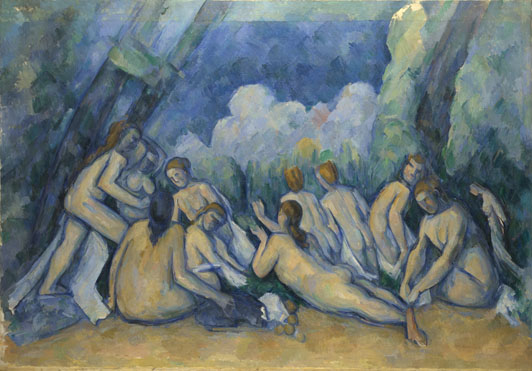I don’t like Cezanne’s The Bathers (Le Grandes Baigneuses). Regretfully, I am unable to visit the National Gallery often; but when I do, I rush past it, unlike many who look at it admiringly. It evoked antagonism also among Cézanne’s contemporaries, but today it is regarded as a masterpiece.
Paul Cézanne (1839-1906) is often referred to as ‘the bridge between the nineteenth-century and the twentieth’, a French painter who laid the foundations for the innovative spirit that followed Impressionism. Daring, unconventional, breaking a new path, he had extensive influence on modern artists like Matisse and Picasso. The American essayist Clement Greenberg said Cézanne “is the most copious source of what we know as modern art, the most abundant generator of ideas and most enduring newness”.
Cézanne began working on this painting in 1870, and concluded it in 1906, months before his death. The theme, nude women bathing in a landscape, is an interpretation of previous works by Titian and others. These somewhat strange women, so utterly different from previously known paintings of female figures, evoked both antagonism and immense interest; heavy, sturdy, with blurred contour lines, and almost faceless. They are entirely remote, for example, from the delicate depiction of nude women by Renoir (The Large Bathers, 1887). Clearly there is a strong erotic note – they are exposing their naked bodies. But the painting is far from an ode to feminine beauty.
Art history suggests two lines of interpretation. The first disconnects the painting from the non-pictorial world: these figures depict neither real women nor anything outside art itself. Cézanne’s only goal was to perfect the language of painting. It invokes works of artists of various periods. The figures are very flat, deviating from the traditional attempt to create an illusion of depth, their contours are blurred, ‘tipsy’, some say, and Cézanne’s typical repetition of short brush strokes is clearly visible. Their beauty lies in understanding how they came into being, how the artist brought about his unique perception of art via brushes and colors.
The other line of interpretation relates to the personality and life of Cézanne. In his youth he admitted a fear of women and had the most violent sexual fantasies. This disposition is evident in his early works. The bathers are a sublimation of adolescent fantasies, an attempt to address sexuality. In the words of art historian Meyer Schapiro, “The emotionality of his early pictures returns into a new form”. This is a mature man bringing his previous violent urges to the surface and giving them a more refined, sophisticated form.
Last time I visited the National Gallery I decided I would sit on the bench facing the painting and observe it for a while, until I could figure out what it was that made me dislike it so much. After a couple of minutes, I realized I had a feeling that I was a bit of a voyeur: I was watching a group of naked women – not an unusual scene in art – but two of them were looking back at me, creating a most unpleasant feeling. If these two women are ignored, the impression the painting creates is altogether different.
To put it very generally, works of art can exemplify one of two views: either the spectators adopt the illusion that the people depicted in a painting are unaware of the painter watching them, or they explicitly acknowledge his presence. This is, of course, also true for paintings of human nudity. In Renoir’s Bathers, for example, the bathers are ’ignorant’ of the painter. We all accept the code of pretending the women don’t know they are being seen naked. And an opposite example could be Titian’s Venus of Urbino, a naked woman looking straight at the painter. Of course, these two fundamental perspectives evoke two completely different sets of emotions.
But Cézanne’s The Great Bathers has a most oppressive mixture of both attitudes. Most women in the painting are oblivious of the painter. But two figures turn their heads and watch us directly, in a disturbing manner: one, sitting in the centre, turns and looks backwards – alarmed, almost angry, as if caught by surprise. The other, sitting on the right hand side, watches us aloofly, curving her back, perhaps to conceal her breasts.
Cézanne, then, places the spectator in a most unpleasant position: he feels confortable watching naked women who are unaware that their bodies are exposed. At the same time, two women seem disturbed by us watching them naked; and this, in turns, is extended to include all the other women in the painting.
Nothing is more modern then Cézanne’s blurring of the boundaries: between the illusionism of traditional art and these two naked women gazing directly at us; between delving into a work of art and facing blatant female nudity; between high art and a hint of pornography.
I hate it.

Probably not 🙂
Then, you won’t like NYMPHAEUM 1878 by William Adolphe Bouguereau